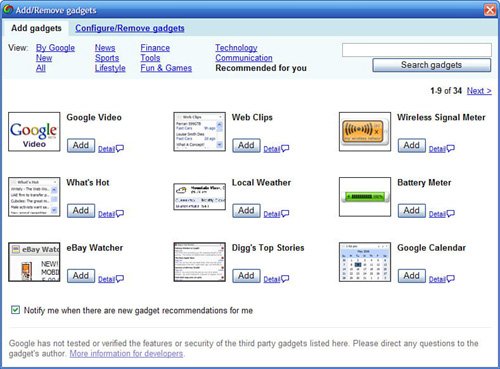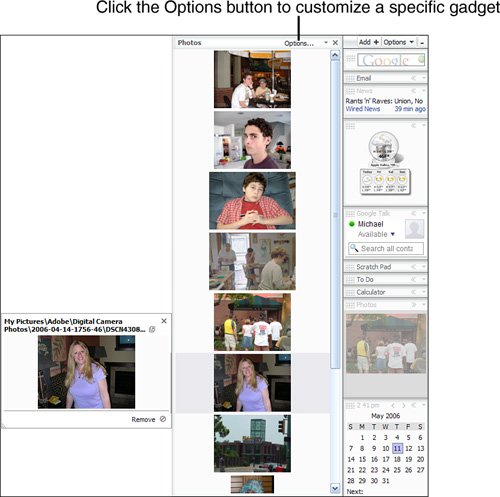Using the Google Desktop SidebarAs I noted in the introduction to this chapter, Google Desktop is more than just a desktop search. It's also about putting more information on your desktop, via the Google Desktop sidebar. As you can see in Figure 32.18, the sidebar resides on the far right of your computer desktop (by default, anywayyou can change this) and includes a variety of different content modules, which Google calls gadgets. You can choose from hundreds of different gadgets to display all sorts of information. Figure 32.18. The Google Desktop sidebar.
Different Ways to Display the SidebarThe sidebar is activated by default when you first install the Google Desktop program. You can turn it off by selecting Options, Close. (That's clicking the Options button at the top of the sidebar, and then selecting Close.) To redisplay it, right-click the Google Desktop icon in the Windows system tray and select Sidebar from the pop-up menu. By default, the sidebar appears on the right side of your desktop. You can move it to the left side of the desktop by selecting Options, Dock Sidebar, Left. To change the width of the sidebar, just drag the left (or right) side of the sidebar until the sidebar is the desired size. If you don't want the sidebar taking up all that screen real estate, consider using the auto-hide feature. When this option is selected, the sidebar is hidden until you move the cursor to the far right side of the screen. When you do this, the sidebar pulls out for your use. To activate auto-hide, select Options, Auto-Hide. Working with Sidebar GadgetsThe fun thing about using the Google Desktop sidebar is selecting which gadgets you want displayed. There are tons of different gadgets available, as we'll discuss in the next section; you can insert as many as you have room for. To add a new gadget to the sidebar, click the Add button. This displays the Add/Remove Gadgets dialog box, as shown in Figure 32.19. From here you can view gadgets in a number of different categories (By Google, New, Finance, Technology, Communication, and so on); click the Add button next to a gadget to add it to your sidebar. Figure 32.19. Selecting new gadgets for the sidebar.
To remove any gadget from the sidebar, click the down arrow in that gadget's title bar, and then select Remove. (You can always restore the Gadget by clicking the Add button at the top of the sidebar, if you like.) In the sidebar, any gadget can be displayed at any height, or collapsed to just its title bar. Making a gadget taller or shorter is a simple matter of dragging the top border up or down with your mouse. Collapsing the gadget entirely is done by clicking the gadget's down arrow, and then selecting Collapse. You can rearrange the gadgets in your sidebar in any order. It's a dynamic process; just grab the gadget's title bar with your mouse and drag it into a new position. The other gadgets rearrange themselves to make room for the moved gadget. Most gadgets have an expanded view, which you display by clicking the left arrow in the gadget's title bar. This expands the gadget to the left, where (in most cases), more options are available than in the standard gadget. (Using the expanded view is also a necessity when you have the gadget collapsed.) For example, Figure 32.20 shows the expanded view of the Photos gadgetwith an additional expansion for the selected photo. Figure 32.20. The Photos gadget in expanded view.
Individual gadgets can also be undocked from the sidebar. When you click the down arrow in the gadget title bar and then select Undock from Sidebar, the gadget is moved from the sidebar to its own window on the desktop. (Figure 32.21 shows the undocked version of the Weather gadget.) To redock a gadget, click the gadget's down arrow and select Dock to Sidebar. Figure 32.21. An undocked gadget.
|